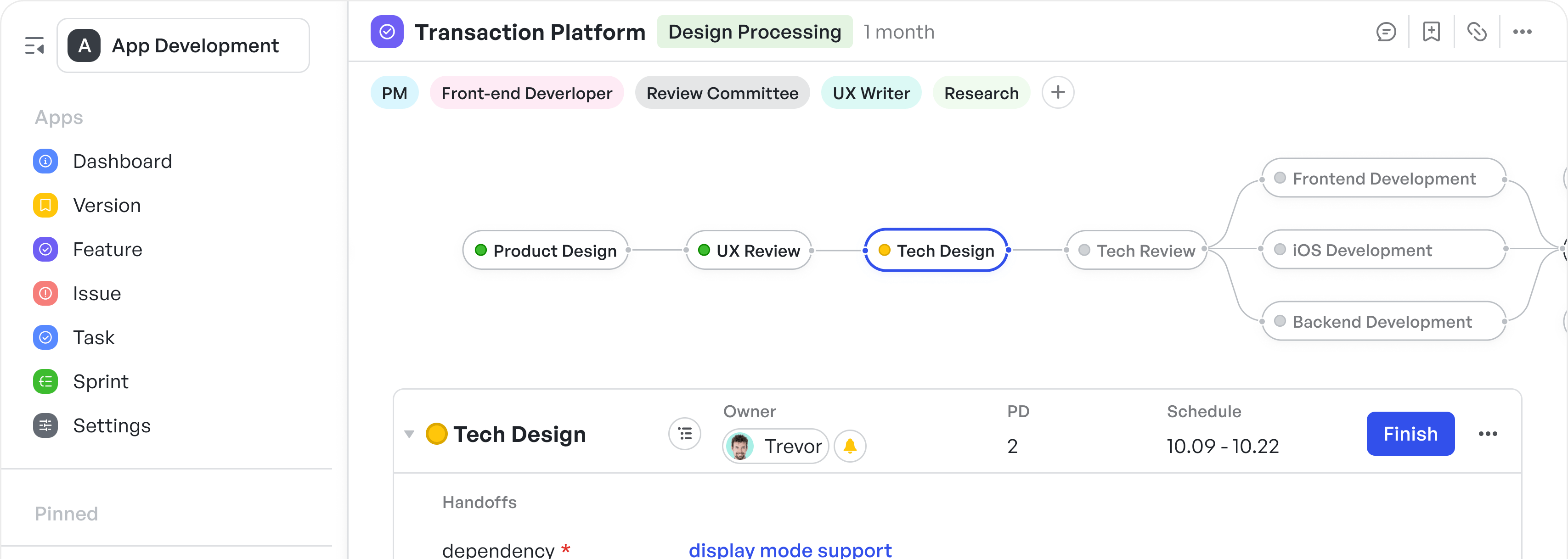When it comes to leading teams, three things matter most: managing change, aligning a common vision, and achieving the desired outcomes. These priorities are especially crucial in agencies, where roles like project managers and product managers play a key part in driving success.
Although the titles may sound similar, the roles of project managers and product managers are not quite the same. At first glance, the difference seems straightforward. Project managers oversee specific projects, while product managers focus on a product from beginning to end.
But as you dive deeper, the lines between these two roles can blur, and the differences become more apparent. Both roles are essential to a business’s success, yet each has its own responsibilities and ways of working.
In this article, we'll discuss the differences between project managers and product managers and explore how they collaborate to propel your business forward.
The Rise of Product Management
In recent years, product management has evolved from a behind-the-scenes support function to a central strategic role, especially in tech-driven businesses. According to a recent report, nearly 60% of companies across various industries now consider product management a key driver of growth. This shift reflects the increasing recognition of the role’s importance in delivering products that meet market needs and align with business goals.
Product management encompasses several core functions crucial to a company’s success. First, product lifecycle management ensures that products are developed, launched, and optimized efficiently. Managers oversee everything from idea conception to market delivery, continuously assessing the product’s performance.
Market research is pivotal in understanding consumer needs, industry trends, and competitive landscapes. Finally, product managers focus on customer experience, ensuring the product resonates with users and delivers value.
These functions work together to ensure that products not only fulfill customer demands but also drive business growth, improve market positioning, and support overall strategy. With businesses increasingly investing in product teams, it’s clear that product management is no longer just about development—it’s about leading innovation.
Product Management vs. Project Management
When comparing product management to project management, it's important to understand that these roles are not interchangeable.
For example, a product manager is responsible for the product’s vision. This includes everything from initial development and design to production and launch. They collaborate with design, engineering, marketing, and development teams to bring a product to market. Key skills for product managers include strategic thinking, problem-solving, and taking full responsibility for the product’s success.
On the other hand, a project manager handles the coordination and execution of specific projects. They ensure that all team members stay aligned throughout the project life cycle.
While product managers focus on the long-term vision and strategy, project managers are more concerned with the immediate tasks and objectives. Their primary goals are to manage time effectively and keep the project on budget.
Now that we have a fair understanding of both roles, let’s take a look at how a product management software differs from a project management software.
Product Management Software vs. Project Management Software
Project and product development teams need the right tools and technologies to stay effective and efficient.
Project management software is critical in helping project managers control costs, meet deadlines, and track progress. It ensures that development teams stay on course, delivering projects on time and within budget. These tools help manage every aspect of a project’s lifecycle from task allocation to time tracking.
On the other hand, product management software offers distinct advantages for product managers. These tools help shape product strategy, prioritize features, and create seamless prototypes that align with business goals. By providing valuable insights, they support the entire product development process, from ideation to launch, ensuring the end result meets both customer and market needs.
Now, let’s dive into the differences between product management software and project management software with a quick comparison table:
Project vs. Program Management
Both project management and program management are essential for delivering successful results in businesses, but they focus on different aspects of work.
While project management focuses on executing individual projects, program management takes a broader view by overseeing multiple interconnected projects that contribute to larger organizational goals.
What is Project Management?
Project management involves planning, executing, and closing a specific project. A project is typically a temporary initiative with a clear goal, timeline, and defined deliverables. The project manager is responsible for ensuring the project is completed on time, within budget, and meets the required scope and quality.
Key responsibilities of a project manager include:
- Defining project goals and scope
- Allocating resources
- Monitoring progress and handling risks
- Ensuring stakeholder satisfaction
What is Program Management?
On the other hand, program management involves managing a group of related projects that contribute to a broader organizational goal. A program is ongoing and often involves multiple projects to achieve strategic objectives.
The program manager coordinates these projects, aligning them with business goals and ensuring that each project’s outcome contributes to the program's overall success.
Key responsibilities of a program manager include:
- Defining the program's strategic objectives
- Coordinating cross-project dependencies
- Managing program resources and budgets
- Aligning multiple projects with the company’s long-term goals
- Mitigating risks across all projects
Dimension 1: When—Product and Project Life Cycles
250px|700px|reset
加载中,请稍后
The life cycle of a product is generally much longer than that of a project. A product's life cycle spans from the initial market research phase through development, operation, and eventual decommissioning.
Conversely, projects are usually shorter in duration. They are temporary efforts to deliver a unique result, service, or change. Think of a project as a focused sprint within the broader journey of a product.
If you were to visualize both life cycles on a timeline, you’d notice that projects fit into the middle of a product’s life cycle. Product management, by contrast, covers a much longer period. It stretches over the entire life cycle of a product, from ideation and development all the way to retirement.
Dimension 2: What—Product and Project Activities
250px|700px|reset
加载中,请稍后
Product and project managers share many common responsibilities, and their activities often overlap. Both roles align work with company strategy, manage various stakeholder groups, and prioritize tasks. These key activities are listed along the y-axis, with examples shown for clarity.
However, there's a difference in the focus of their work. Project management typically focuses on task execution and ensuring stakeholder engagement. Project managers are more concerned with coordinating efforts and meeting short-term goals rather than shaping broader strategy.
In contrast, product management covers similar tasks but with a stronger emphasis on product strategy. The scope of their work is broader and longer-term. Product managers are not just considering the current project but the product’s entire life cycle, from development to retirement.
While comparing the timeline and activities helps clarify some of the overlap, there’s a critical difference between the two roles: "Who do they serve?" This distinction reveals an essential difference, which we can capture by adding a third dimension—focusing on whether the role is more internally or externally focused.
Dimension 3: Who—Product and Project Service Focus
250px|700px|reset
加载中,请稍后
Both project and product managers ultimately aim to serve and delight customers, but their focus differs in terms of who they are primarily serving.
Project managers typically balance their customer focus with an emphasis on internal sponsors. They work closely with stakeholders inside the company and ensure that the project aligns with the sponsor’s expectations.
On the other hand, product managers focus on the customer and the external market environment. Their role includes analyzing competitors, trends, and market needs, which shape the product strategy.
To better visualize this, imagine a three-dimensional landscape. In this view, project management is more focused on serving both the customer and the internal sponsor, represented toward the back of the space on the z-axis. The project manager’s activities are more centered on internal processes and meeting internal goals while considering customer needs.
In contrast, product management is shifted toward the front of this landscape, where the focus is on the customer and the external market. Product managers are deeply immersed in market research, customer feedback, and long-term product strategies.
It’s important to note that while there are differences in focus, these are not strict boundaries. Product managers still have internal sponsor responsibilities, and project managers should incorporate external market insights when managing projects. These areas—though important—require less attention than core responsibilities like task execution or long-term strategy.
How Meegle Fits into Product and Project Management
Meegle is a powerful all-in-one platform that streamlines both product and project management. It integrates task management, real-time collaboration, and project visibility, enabling teams to break down complex projects into manageable workflows. Whether you're managing the development of a product or managing a project, Meegle gives you the tools you need to stay organized, increase efficiency, and improve team collaboration.
Meegle's seamless integration and intuitive features ensure that project and product managers can effectively manage tasks, track progress, and prioritize goals. The platform’s flexibility allows teams to customize workflows, maintain full visibility, and achieve better outcomes.
Streamline Roadmap Management Easily and Efficiently
Having a clear, actionable roadmap is crucial in both product and project management. Meegle’s roadmap feature empowers managers to structure and visualize goals, epics, features, and tasks, providing teams with a clear path forward.
250px|700px|reset
加载中,请稍后
Make swift adjustments to goals, reprioritize features, and promptly address emerging issues
For example, a product manager might set a high-level goal like “improve user experience” and break it down into specific objectives such as “optimize mobile app speed” and “redesign homepage layout.” Meegle’s tree view allows you to easily organize these goals, while its filtering options help you quickly access detailed features and track progress.
Whether managing product iterations or overseeing a project’s milestones, Meegle lets you zoom in and out of your roadmap with ease. You can quickly adjust priorities, reassign tasks, and ensure your vision is realized as changes occur, giving you full control over your product’s direction and project execution.
Manage Product and Project Releases
Managing releases is a complex process, whether you’re launching a product update or a major project milestone. Meegle simplifies this by providing a structured way to manage all aspects of your release, from planning to execution.
The platform’s tree view lets you organize release details, such as new features and potential issues, in an easy-to-follow hierarchy.
250px|700px|reset
加载中,请稍后
Make informed decisions, track feature status and assign tasks effectively
For instance, when launching a new product version or a project deliverable, Meegle ensures that every team member understands the scope and current status of the release. You can track the status of each feature, monitor any known issues, and assign tasks to team members with precision.
This clear, organized approach allows project and product managers to make informed decisions and execute releases smoothly.
Optimize Role Management to Foster Team Collaboration
Effective role management is essential for fostering smooth collaboration across teams. Meegle allows managers to assign roles dynamically based on specific conditions, making it easier to manage team members across projects and products.
This flexibility is particularly useful in environments like IT departments, where team responsibilities may change frequently depending on the project's stage or specific requirements.
For example, if your IT team is actively working on a product launch or managing a project update, Meegle lets you assign roles quickly and ensure that the right people are working on the right tasks.
This dynamic role assignment capability helps improve collaboration, avoid bottlenecks, and ensure the project or product is progressing as planned.
Streamline Feature Management with Read-to-Use Templates
Meegle’s Feature Management Templates offer teams a huge advantage in managing the entire feature development lifecycle. From initial ideation to final delivery, these pre-configured templates help product and project managers plan, track, and execute feature development efficiently.
250px|700px|reset
加载中,请稍后
Empowers teams to streamline the entire feature development lifecycle, from ideation to delivery
The templates are customizable, allowing you to adapt them to your team’s specific needs. Whether you’re working on a product roadmap, a project launch, or an R&D initiative, Meegle’s templates provide a structured approach to streamline the process.
Meegle also includes powerful real-time analytics and automation capabilities. With triggers and predefined conditions, you can automate routine tasks, ensuring your team stays focused on high-priority actions. These features enhance productivity and give managers valuable insights into feature progress, helping teams deliver on time and within scope.
Some of the key benefits of Meegle’s Feature Management Templates include:
- Visualize the entire feature development lifecycle for better planning and execution
- Streamline collaboration across teams and stakeholders
- Track progress in real-time with detailed analytics
- Automate routine tasks to improve productivity and focus on critical work
By using Meegle’s templates, your team can accelerate product development cycles, optimize workflows, and ensure every feature reaches its full potential.
Benefits of Using Meegle for Streamlined Communication and Tracking
Effective communication and real-time tracking are essential for the success of both product and project management. Meegle simplifies this by offering a powerful integration with tools like Slack and Lark, allowing teams to stay connected and informed at all times, no matter where they are.
Boost Communication with Slack & Lark Integration
Meegle's seamless integration with Slack and Lark ensures that teams never miss an important update. With these integrations, you can receive real-time notifications directly in your messaging platform whenever a task is updated, a milestone is reached, or the project status changes. This helps keep everyone on the same page and avoids communication challenges.
250px|700px|reset
加载中,请稍后
Enable members to create/join groups and receive/send message notifications across different platforms
For instance, if a team member updates a task’s progress or a new issue is assigned to someone, Meegle can send a notification straight to your Slack or Lark Group Chat. This instant communication ensures quick response times and helps prevent delays. Whether you're managing a product launch or handling multiple projects, Meegle's integration with Slack and Lark enables more effective collaboration and quicker decision-making.
Some of the key benefits of Meegle’s integrations with Slack and Lark:
- Receive updates instantly in Slack or Lark channels for seamless communication
- Set custom triggers to notify teams about important changes or updates automatically
- Keep everyone on the same page, ensuring swift responses and preventing miscommunication
- Stay on top of deadlines, tasks, and project milestones effortlessly
Real-Time Notifications for Effective Management
With Meegle’s automated notifications, you can track project milestones and manage product updates effortlessly. The system sends custom alerts based on the tasks and updates you deem most important. This feature ensures that critical changes or deadlines are not overlooked.
For example, you could configure Meegle to notify your team when a task is delayed, when a project is ahead of schedule, or when a key product feature has been completed. These notifications allow you to stay agile and respond to changes proactively.
Automate Workflow with Meegle’s Notification Triggers
Meegle also offers automation operations, allowing you to set triggers that automatically notify your team based on specific conditions or actions taken within the platform. These triggers can be set up to streamline your workflow and ensure that nothing falls through the cracks.
250px|700px|reset
加载中,请稍后
Set up automated notifications for custom triggers with Meegle
For instance, if a new feature is pushed into development or a project moves from one phase to the next, Meegle can automatically notify all relevant team members, keeping everyone aligned. This automation reduces manual tracking and ensures that all tasks, whether project-related or product-related, move forward without unnecessary delays.
Keep Product Managers and Project Managers on Track With Meegle
Whether you're managing projects or products, a central hub for tasks, timelines, and communication can significantly boost efficiency.
For improved transparency, smoother collaboration, and better task management, give Meegle a try — for free. It provides teams with real-time insights into project progress, ensuring everyone from product managers to project managers (and their teams) stays aligned, focused, and collaborates effortlessly.





